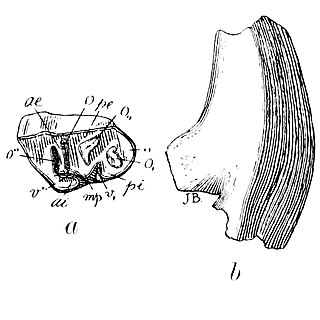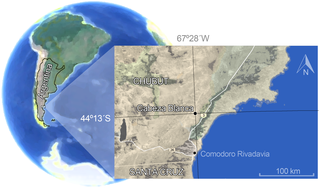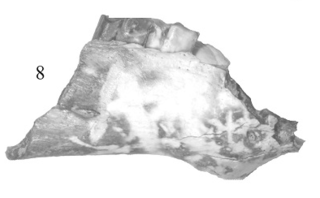
Mesotheriidae is an extinct family of notoungulate mammals known from the Oligocene through the Pleistocene of South America. Mesotheriids were small to medium-sized herbivorous mammals adapted for digging.
The Divisaderan age is a South American land mammal age, covering a period of geologic time within the Middle and Late Eocene epochs of the Paleogene. It follows the Mustersan age and is followed by the Tinguirirican age.
The Tinguirirican age is a period of geologic time within the Late Eocene and Early Oligocene epochs of the Paleogene, used more specifically within the SALMA classification in South America. It follows the Divisaderan and precedes the Deseadan age.
The Deseadan age is a period of geologic time within the Oligocene epoch of the Paleogene to the Early Miocene epoch of the Neogene, used more specifically within the SALMA classification of South America. It follows the Tinguirirican and precedes the Colhuehuapian age.

Proplatyarthrus is an extinct genus of ground sloths of the family Megalonychidae, endemic to Chubut Province, Argentina in South America.
Abanico Formation is a 3 kilometres (9,800 ft) thick sedimentary formation exposed in the Andes of Central Chile. The formation has been deposited in a timespan from the Eocene to the Miocene. Abanico Formation's contact with the overlying Miocene Farellones Formation has been the subject of differing interpretations since the 1960s. A small part of the formation crops out in the Mendoza Province of western Argentina.
Ernestokokenia is an extinct genus of mammal, belonging to the Didolodontidae. It lived during the Early Eocene and the Middle Eocene, and its fossils were discovered in South America.
Pseudhyrax is an extinct genus of archaeohyracid notoungulate. It lived from the Late Eocene to the Early Oligocene, of what is now South America.

Argyrohippus is an extinct genus of notoungulate, belonging to the family Notohippidae. It lived from the Late Oligocene to the Early Miocene, and its fossilized remains were found in South America.

Morphippus is an extinct genus of notohippid notoungulate that lived during the Middle to Late Oligocene in what is now South America.
Ignigena is an extinct genus of notoungulate belonging to the family Interatheriidae. The only known species of this genus is Ignigena minisculus. The genus name means born from the fire, referencing the volcanic deposits in which its fossils were found, while the type species name minisculus means "minuscule", referencing the small size of the animal. It was related to Johnbell. I. minisculus was a small animal with elongated teeth. Its fossilized remains were found in Chile, in deposited dating to the Early Eocene.
Argyrohyrax is an extinct genus of interatheriid notoungulate that lived during the Late Oligocene, of what is now Argentina and Bolivia.

Notopithecus is an extinct genus of Notoungulate, belonging to the suborder Typotheria. It lived from the Middle to the Late Eocene and its fossilized remains were discovered in South America.

The Sarmiento Formation, in older literature described as the Casamayor Formation, is a geological formation in Chubut Province, Argentina, in central Patagonia, which spans around 30 million years from the mid-Eocene to the early Miocene. It predominantly consists of pyroclastic deposits, which were deposited in a semi-arid environment. It is divided up into a number of members. The diverse fauna of the Sarmiento Formation, including a variety of birds, crocodilians, turtles and snakes, also includes many mammals such as South American native ungulates as well as armadillos, and caviomorph rodents.
Boleatherium is an extinct genus of interatheriid notoungulate that lived from the Early to Middle Miocene of what is now Argentina. Fossils of this genus have been found in the Cerro Boleadoras Formation, the formation which this genus was named after.

Eopachyrucos is an extinct genus of interatheriid notoungulates that lived from the Middle Eocene to the Late Oligocene of Argentina and Uruguay. Fossils of this genus have been found in the Sarmiento Formation of Argentina and the Fray Bentos Formation of Uruguay.
Rosendo is an extinct genus of notohippid notoungulates that lived during the Early Oligocene in what is now Argentina and Chile. Fossils of this genus have been found in the Sarmiento Formation and the Abanico Formations of Argentina and Chile.

Proargyrohyrax is an extinct genus of interatheriine notoungulates that lived from the Early to Middle Oligocene in what is now Argentina. Fossils of this genus have been found in the Sarmiento Formation of Argentina.
Federicoanaya is an extinct genus of interatheriine notoungulates that lived during the Late Oligocene in what is now Bolivia. Fossils of this genus have been found in the Salla Formation of Bolivia.
Brucemacfaddenia is an extinct genus of interatheriine notoungulates that lived during the Late Oligocene in what is now Bolivia. Fossils of this genus have been found in the Salla Formation of Bolivia.
















